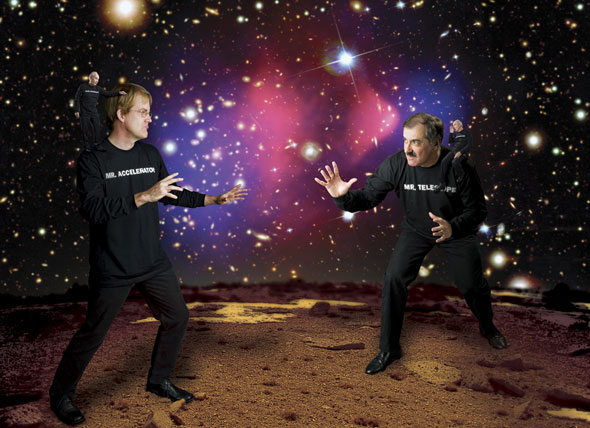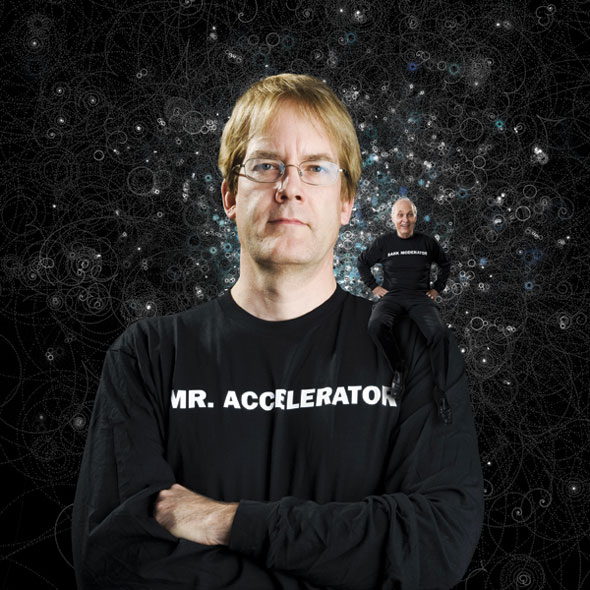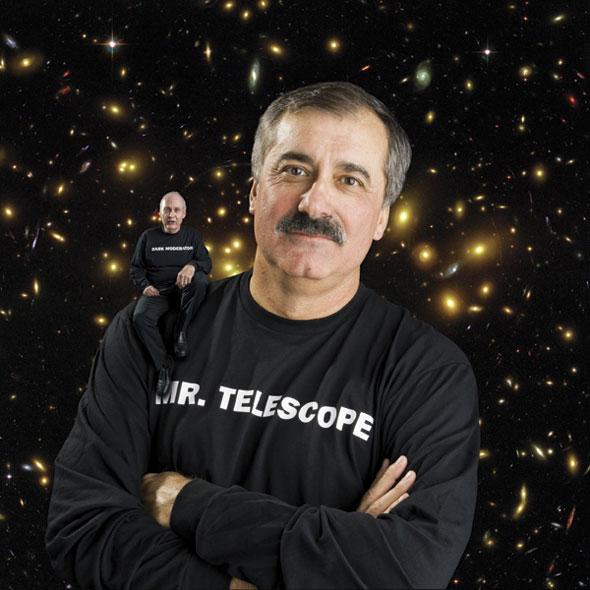The dark universe debate
Who will be the first to prove the existence of dark matter and dark energy? A particle physicist and an astrophysicist go head to head.
By Kathryn Grim
 |
| Particle physicist Joe Lykken, Fermilab; astrophysicist Rocky Kolb; and University of Chicago astrophysicist Michael Turner, who served as moderator of the debate. Photos: Reidar Hahn, Fermilab Photo-illustration: Sandbox Studio |
The way Joe Lykken sees it, every modern scientist has moments of jealousy when pondering the endless opportunities open to researchers of yore. How easy it must have been to come up with discoveries in the days before people knew what atoms were, or how gravity worked.
Its easy to think they had all these great things just lying around to discover, and its not like that anymore, the Fermilab particle physicist said.
But thats not true, he said: The more scientists learn, the more they realize that the whole universe is up for grabs.
Researchers understand only the four percent of the universe made up of atoms, compared to the 96 percent that they think is composed of dark matter and dark energy. Scientists have found evidence of dark matter and dark energy, but no one knows what they are.
Scientists from multiple disciplines are taking up the search—looking for these exotic entities in space, waiting for them underground, and trying to create them in particle accelerators. The question is: Whos going to get there first?
Lykken and University of Chicago astrophysicist Rocky Kolb playfully duked it out over their fields sibling rivalry Sept. 24 in The Dark Side of the Universe, a public discussion of dark matter and dark energy.
Lykken argued that particle physicists will be the first to find evidence of dark matter and dark energy, using particle accelerators and detectors buried in mines or polar ice caps. Kolb said astrophysicists would be first with the help of satellites, telescopes, and those same underground detectors.
They spoke to a crowd of almost 400 at the Smithsonian Museum of Natural History in Washington, DC. Michael Turner, an astrophysicist at the University of Chicago who coined the term dark energy, moderated.
The stuff were talking about tonight really, really dazzles, Turner said. But why should the taxpayer invest in this? Why should the man or woman on the street be interested in answers to these questions about the dark side?
Lykken responded by pointing out that quantum mechanics—the study of the interaction of particles at the smallest level—seemed at first to be a purely intellectual exercise with no practical application. But it led to the invention of electronics, including the computer. And the seemingly egg-headed pursuit of playing with the connection between magnetism and electricity led to the technology that runs todays power plants.
 |
| Photos: Reidar Hahn, Fermilab Photo-illustration: Sandbox Studio Background image: Bubble Chamber Strange Event algorithm, Jared Tarbell 2004 |
United by a search in the dark
Scientists first found evidence of dark matter in 1935. They theorized that clusters of dark matter formed the backbones of galaxies, holding them together as planets and stars formed.
About a decade ago, scientists discovered that an opposite force was pushing the universe apart, causing it to expand at an accelerating rate.
The search for an understanding of dark matter and dark energy has given a common goal to scientists who once operated independently, Lykken admitted.
Until recently, Lykken said, ribbing Kolb, particle physicists considered astronomers like Rocky to be insomniacs who stayed up all night taking pictures we didnt care about.
But then, Lykken said, particle physicists realized that their theory of supersymmetry predicted the existence of something similar to the dark matter astrophysicists were seeking. Supersymmetry holds that every known particle has a corresponding particle that behaves in a different way. This theory would help fill in the missing pieces of how the building blocks of matter and forces of nature work to create objects. The lightest of these predicted superpartner particles, the neutralino, is a leading candidate for the dark matter thought to have existed since the very early, high-energy days of the universe, where it helped matter cluster together to form galaxies.
Supersymmetry has explained both how the subatomic world holds together and how the galaxies and cosmos hold together, Lykken said. Its this inner-space, outer-space connection.
I see, Turner mused. So you werent interested in [dark matter]. But once you saw it was important, you remembered that you predicted it.
Well, Lykken said, cheering on his particle physics colleagues, it turns out we also predicted dark energy. Particle physicists had called it vacuum energy and Albert Einstein had called it the cosmological constant, and they all shared the basic idea that empty space isnt empty at all.
We can tell theres something there, Lykken said, because when we smash particles together, they seem to get knocked around a little bit by the vacuum of space.
 |
Shining light on dark matter
Particle physicists hope to find dark matter in one of two ways: either by producing it in a particle accelerator or by identifying it with ultra-sensitive underground detectors as it passes through the Earth. Many believe the reason particle accelerators have not yet found dark matter is that it would take a substantial amount of energy to make it—a level of energy the newly minted Large Hadron Collider at the border of Switzerland and France could produce.
My guess is that the LHC is going to find something thats really going to shake our fundamental knowledge of physics, said Lykken, who is working with the LHCs Compact Muon Solenoid experiment.
Asked whether scientists will discover dark matter within the next three years, Lykken said yes, the LHC will produce dark matter by that time.
Kolb shot back, We will first discover it with astronomy— within two and a half years.
Two clues have led astronomers to suspect the existence of dark matter, Kolb said.
First, when they measured the masses of the stars and planets that make up galaxies, they discovered that the gravity of those atom-built objects alone was not great enough to hold the galaxies together. Something they couldnt see must contribute mass—and hence a gravitational pull—as well.
Second, they could see distortions of light in space, normally caused by large masses, in places that seemed empty. They called this invisible presence dark matter.
Youre sure [dark matter] is there? Turner asked.
I would bet your life, Kolb replied.
 |
Detecting dark energy
The researchers werent as confident of success in the hunt for dark energy, a mysterious form of energy that would push the universe to expand at faster and faster rates. Both said the best possible development could be proving that, contrary to Turners prediction, dark energy does not exist. This would give them a blank check to start over with new theories.
Just for the record, it was a Tuesday in 1964 when I made a mistake, Turner cracked. I just want the record to show that there was a time I made a mistake. Its not impossible.
Astronomers came up with idea of dark energy after they measured the rate at which the universe was expanding a long time ago, compared to how fast it expanded more recently.
They found their basis of comparison by looking at faraway objects in space: supernovae, or exploding stars. These explosions always put out the same amount of light. Measuring how faint these supernovae are as seen from Earth, scientists can tell exactly how far away they are.
Because light takes time to travel to the Earth, the distant supernovae also allow scientists to look back in time. When scientists look at objects that are far away, they actually see how they looked in the past. So as I look out here in the audience, people in the back seem younger to me, Kolb joked.
Astronomers had expected the expansion of the universe to slow over time, since gravity would pull things back in. To their surprise, they discovered that the expansion was speeding up; the supernovae were moving away from us at a faster and faster clip. It seemed some other force was pushing these objects—and everything else in the universe—apart.
While Turner believes this is best explained by the repulsive gravity of dark energy, he said there could be some other explanation for these surprising observations. Hit me with your craziest idea, he said to Lykken and Kolb. Really, really crazy. Paris Hilton kind of crazy.
Kolb said dark energy could be the ether of the 21st century. Early theorists thought this hypothetical substance filled the universe and allowed light to travel through what would otherwise be empty space. After finding the speed of light to be the same in different directions of space, experimenters refuted the ether concept.
We think [dark energy] is there, but perhaps dark energy isnt there and theres something even odder going on, even more surprising, Kolb said. One possibility that Ive worked on is that the universe is so inhomogeneous that somehow, in some unknown way, this changes the expansion of the universe and makes us think theres dark energy. So if this idea is correct, the way weve been doing the basic equations of cosmology since 1922 would be changed.
Im the only person who thinks this, by the way, he added, to laughter from the audience.
Lykken said the idea of dark energy might be explained by a flaw in our understanding of gravity.
One reason is we may be doing gravity in the wrong number of dimensions, he said. String theorists predict the existence of at least six dimensions in addition to the four space-time dimensions we perceive.
 |
| Photos: Reidar Hahn, Fermilab Photo-illustration: Sandbox Studio Background image: NASA and STScI |
Coming soon
Turner prompted his colleagues to predict where science would be a century from now.
One hundred years ago, Kolb said, astronomers believed the Milky Way galaxy made up the entire universe: I think 100 years from now we will understand the fact that what we today call the universe will just be another small part of something we might call a multiverse or megaverse.
Turner turned to Lykken. Will we have found intelligent life on Earth? he asked.
I think the history of particle physics is finding out theres a new force of nature, Lykken said, new kinds of matter we didnt suspect were there. So I think 100 years from now its very likely well have found at least one new force of nature.
Lykken also predicted we would finally get a handle on how gravity works.
If this doesnt get you interested in science, he said, then I give up.
| Some members of the audience spoke with symmetry immediately after the debate to share their reactions. |
Click here to download the pdf version of this article.






